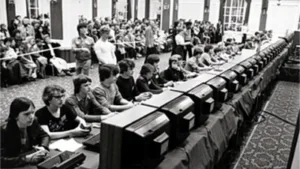Esports is a branch of the immense computer game industry. According to Wikipedia, game competition is almost as old as electronic games themselves with the first formal video game competition held at Stamford University in 1972. The Grand Prize? A one year subscription to Rolling Stone magazine.

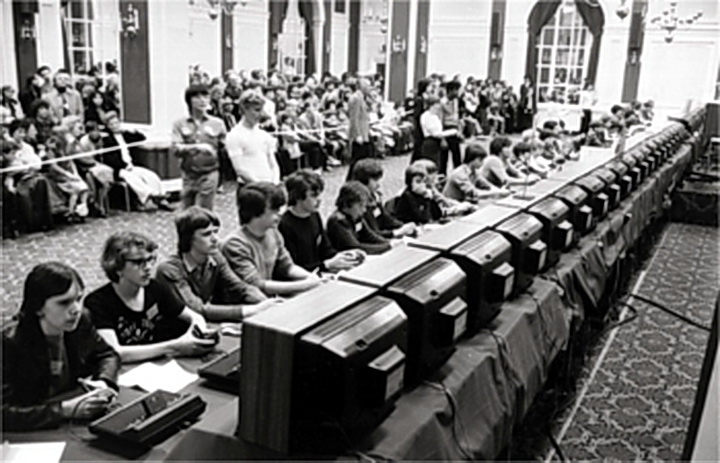 Space Invaders Championship in 1980. (Downloaded from Wikipedia April 1, 2019)
Space Invaders Championship in 1980. (Downloaded from Wikipedia April 1, 2019)
Pong, the first commercially successful video game console, also dates to 1972 although computer-based games pre-date that. Some of these earlier games were based on mainframe computers, so you could only play in the computer’s off-hours, e.g. 3:00 a.m. The Space Invaders Championship, with 10,000 participants, was held by Atari in 1980 and established competitive gaming as a mainstream hobby. Gamers have always been very competitive and who paid for the next round of beer would often depend on the outcome of Pong.
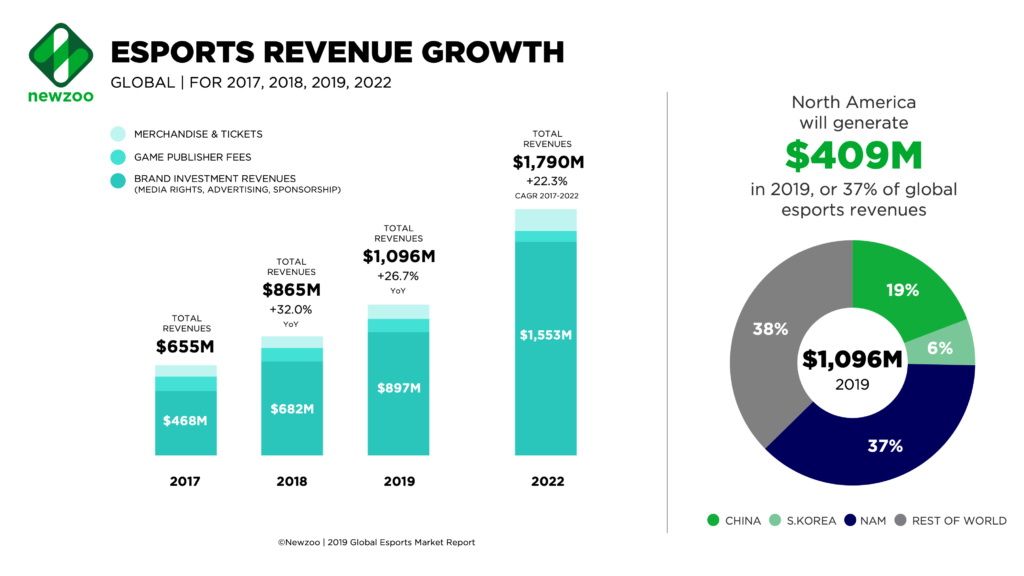 Esports Global Revenue Growth 2017 – 2022 (Credit: Newzoo 2019 Global Esports Market Report)
Esports Global Revenue Growth 2017 – 2022 (Credit: Newzoo 2019 Global Esports Market Report)
Market research firm Newzoo, which specializes in the game industry, has covered esports in its research since 2013. From the relatively humble beginnings in the 70s and 80s, Newzoo research shows esports have become an industry with $865 million of revenues in 2018, forecast to grow to $1,790 million by 2022. This represents a 22.3% CAGR from 2017 to 2022. Most of these revenues ($683 million in 2018) come from what Newzoo calls “Brand Investment” which includes media rights, advertising and sponsorships. Other revenues come from game publisher fees, merchandise and ticket sales.
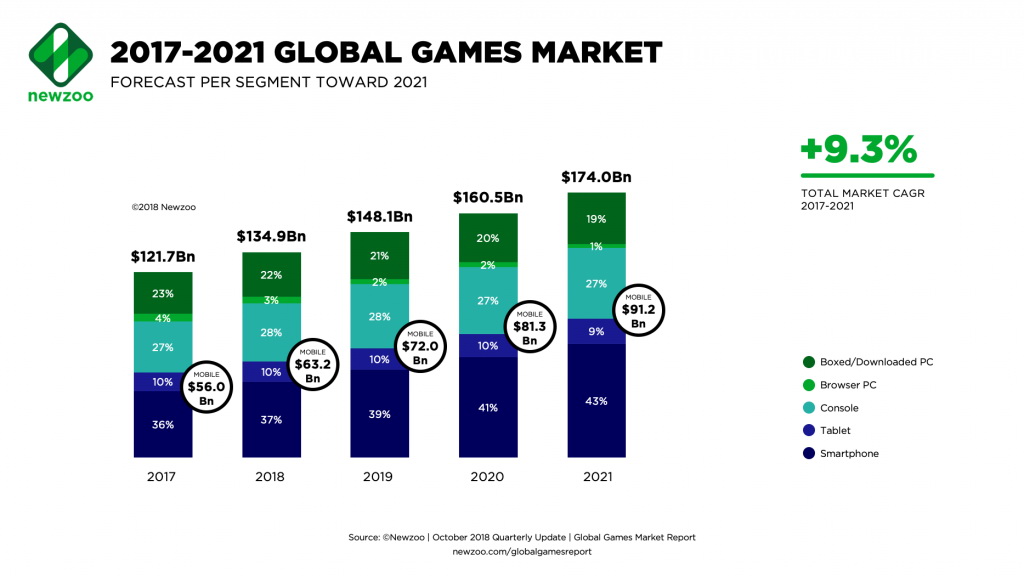 Games Global Revenue Growth 2017 – 2022 (Credit: Newzoo October 2018 Quarterly Update)
Games Global Revenue Growth 2017 – 2022 (Credit: Newzoo October 2018 Quarterly Update)
While esports by itself is a fairly big industry, it is almost a drop in the bucket compared to the total game industry of which it is a part. According to Newzoo, the game industry had $134.9 billion revenue in 2018 and is expected to grow to $174 billion in 2021, for a CAGR of 9.3%.
Mobile games (tablets and smart phones) have grown faster than desktop games, going from less than half of the total revenue in 2017 to slightly more than half of the total revenue in 2021, for a CAGR of 13.0%. The only category that has actually declined in both market share and in total revenue is browser-based PC games. Response time of the game system is critical to all gamers whether they are in an esports tournament, competing against a buddy after school or just playing for their own amusement. Presumably, browser and Internet speed and response time play a major role in the decline of browser-based PC game revenue.
It would be interesting to see whether the greatly reduced response time of 5G services will reverse this trend. Probably not, since mobile games are mostly based on iOS and Android browsers and are growing strongly, even on the current 3G and 4G networks. 5G networks will do little to speed up the desktop browser-based games that are in decline.
 Gamer at an esports tournament. Note the dedicated camera for every gamer. (Credit: Jamie McInall via Pexels)
Gamer at an esports tournament. Note the dedicated camera for every gamer. (Credit: Jamie McInall via Pexels)
Esports is a very display-centric industry, including desktop displays for the players; larger viewing monitors to allow both the program directors and the audience to follow the action; and large, venue-sized LED displays. According to Avixa:
“Some of that substantial pool of [esport] revenue will be put into expanding the venue infrastructure for live competitive e-gaming, in the process creating a new category for the AV integration industry.”
Avixa says there are two categories of esport venues emerging. First is the adaptation of existing venues for esports. The example given for this type of venue is the PiviP Esports Tournament & Video Game Conference scheduled for May 18, 2019 for King’s Island near Cincinnati, said to be the largest amusement and waterpark in the Midwest.
PiviP will actually hold its esports tournament at the Envision Cinema Bar & Grill in nearby Blue Ash, Ohio. In this case, the large video screen for the spectators will be the digital cinema projector in the theater, not an LED display. In addition, Envision Cinema has event space and indoor and outdoor patio space for auxiliary events to go with the esports tournament. This use of existing venues is a good way to have local, regional and one-off events such as PiviP. (Note: Details for PiviP are sparse and in the end it is possible that the Envision Cinema Bar & Grill won’t be used.)
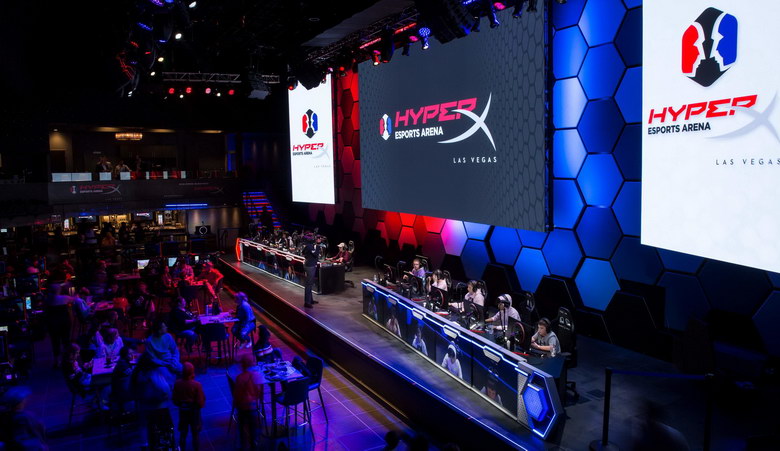 The HyperX Esports Arena at the Luxor Hotel in Las Vegas. (Credit: HyperX Esports Arena)
The HyperX Esports Arena at the Luxor Hotel in Las Vegas. (Credit: HyperX Esports Arena)
One example of the purpose-built esports venue is the HyperX Esports Arena at the Luxor Hotel on the Las Vegas Strip. This dedicated venue includes:
- 30,000 square-foot (2,787m²) multi-level arena
- Broadcast Center & Production Studio
- Esports Exhibition Show Matches
- 50-foot (15.2m) LED video wall
The venue also includes some very Las Vegas-style features including:
- Luxury VIP Lounges overlooking the venue floor
- Gamer-Inspired menu
- Vintage Video Game Cocktail Bar
The venue is set up for not just major esports tournaments and other special events. When no major event is scheduled for the venue, it has video game tournaments for ordinary, non-professional players. These tournaments are like the slots or poker tournaments every Las Vegas casino has. Choose your game and pay to play the game of your choice. On the April 2019 calendar are Fortnite, Whiffs, League of Legends, Overwatch, Super Mario, Apex Legends, Mario Kart, etc. Playing in one of these tournaments costs you from $10/hour to $125 for weekend warriors, with discounts for Las Vegas locals and the military. Prizes vary with the tournament and typically range from $500 – $2000. Prizes in professional esports tournaments can range up to $6 million.
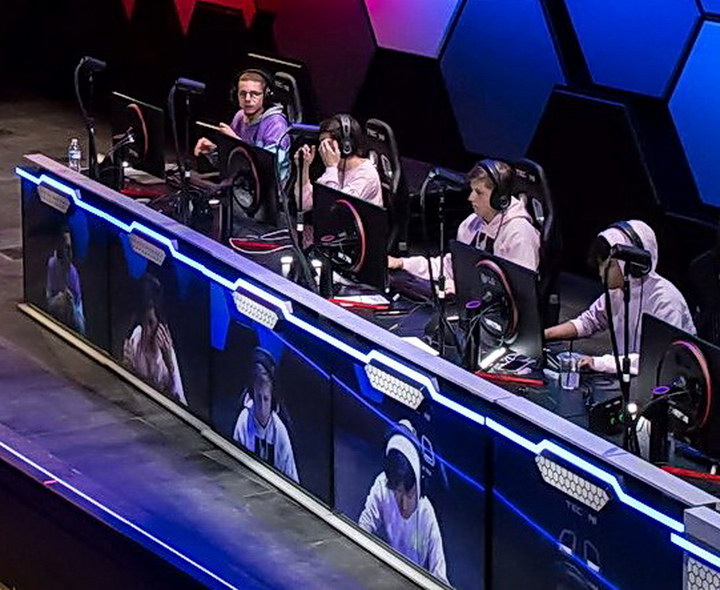 The HyperX Arena has a camera and display screen for every player. The audience has trouble seeing the player directly because the view is normally blocked by his gaming monitor. (Credit: HyperX Esports Arena)
The HyperX Arena has a camera and display screen for every player. The audience has trouble seeing the player directly because the view is normally blocked by his gaming monitor. (Credit: HyperX Esports Arena)
An even larger esports stadium is in operation in Arlington, Texas, located between Dallas and Fort Worth. According to the operators:
“At 100,000 sq. ft. [9,290m²], Esports Stadium Arlington is the largest dedicated esports facility in North America. The facility will serve as a turnkey solution for esports events and productions, built to serve the unique needs and demands of the esports community.”
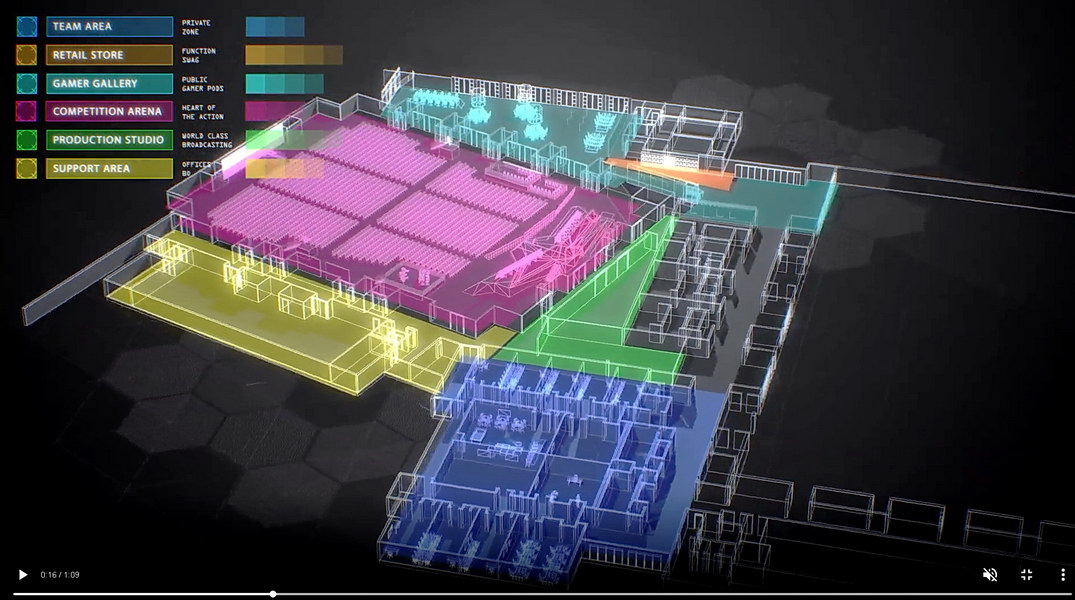 Layout of Esports Stadium Arlington (Credit: Esports Stadium Arlington)
Layout of Esports Stadium Arlington (Credit: Esports Stadium Arlington)
The image above is a screen shot from a one minute video on the Esports Stadium Arlington website that shows off the features of the venue. Besides esports, the venue is said to be suitable for other types of events as well. Special features for this venue include:
- 100,000 sq. ft. dedicated esports facility with a 48,000 sq. ft. (4,459m²) attached exhibit hall
- World-class Stadium, 90 ft. (27.4m) LED stage display with theatrical lights/sound and 2,500 seating capacity
- State-of-the-art broadcast and production studio
- Gamer Gallery with fully furnished PCs equipped with NVIDIA Titan XPs and 240Hz G-Sync monitors
- Modular breakout space for press, catering, VIP lounges and more.
- Eight team training rooms
- VIP Player Lounge
Craig Janssen, Managing Director of Idibri, an AV consultancy and design group in Dallas, believes that the esports industry will initially use more existing venues than dedicated esports venues. “Adapting existing venues makes much more sense economically at this stage, and in many cases some of the AV technology needed is already in place,” he says.
Actually, there is only a minor need for a venue to have an existing audio/video (AV) infrastructure. The rental and staging industry’s bread and butter is taking a venue with minimal AV infrastructure, fully equipping the venue with everything needed for an event, operating it for a few days and then taking all the equipment away again. The basic requirement for a temporary esports venue is a sufficient power supply – esports take a lot of electrical power.
According to Avixa, except for the gaming PCs and monitors themselves, the AV equipment needed for an esports tournament is only a little different from the equipment needed for other rental and staging events or live sports. One requirement Avixa points out is the need for resolution in the displays. Game players, and virtually 100% of the spectators attending an esports tournament are game players themselves, are accustomed to seeing their games on 24” HD monitors from about 2’ (61 cm) away and they demand the same sort of resolution at an esports tournament.
Typically, this means that the large LED display must have a pitch of no more than 2.5mm. The auxiliary monitors scattered around the venue must also support this resolution and there may need to be more auxiliary monitors than are typically used at other rental and staging events. Not surprisingly, AVIXA recommends following the AVIXA standard, Display Image Size for 2D Content in Audiovisual Systems, for the size and resolution of these auxiliary monitors as well as the main venue display.
Sound is often of secondary importance at esports tournaments. The voice of the commentator for the event must be clearly understandable to the audience but concert quality sound is not normally required. While games often have 5.1 or 7.1 surround sound, this is not currently broadcast for the audience to hear. An additional problem is that with multiple players, each player may be at a different point in the game and probably producing a different sound.
 Analysts’ Podium at Esports Stadium Arlington. Note the left hand analyst is featured on the main venue screen behind him. (Credit: Esports Stadium Arlington)
Analysts’ Podium at Esports Stadium Arlington. Note the left hand analyst is featured on the main venue screen behind him. (Credit: Esports Stadium Arlington)
The control rooms at the HyperX Esports Arena and the Esports Stadium Arlington are needed to control all the cameras and other image sources (e.g. every player’s video screen) and route them to the venue’s audience video screens. The control rooms are also needed to prepare the feed for streaming in real time. With a rental and staging-based esports tournament, there is a need to have a similar control room as well. Like a live sports event, it is necessary to have a director to make real time decisions about what content to show on the main and auxiliary screens and a commentator to give a running account of the event. The Esports Arena Arlington has a special analysts’ podium in the venue with room for four analysts and completely equipped with cameras, lights, teleprompters and two-way audio for each analyst.
Esports Stadium Arlington mentions it has eight team training rooms plus a VIP player lounge. Avixa notes that it is necessary for an esports venue to have more backstage space than is normally needed for rental and staging events, due to the need for esports teams to practice before their turn on stage.
Most esports tournaments are also live-streamed. This leads to a problem not common in other sports or rental and staging events. Audience members are not only watching the venue displays but are watching the live stream of the event as well. This means the venue displays may need to have their video signals delayed to match the latency of the live stream. This would be a special problem if there are multiple live streams, for example, the main stream with the announcer keeping track of the event as a whole and the stream of video screen of each of the key players. A gamer in the audience could be watching the main stream on the venue’s displays and his favorite player or team on the live stream.
In this Display Daily, I have focused on esports and the Pro-AV requirements for esport venues. In my next DD, scheduled for publication on April 17, I will focus on the requirements of individual competitors in esports and games, including the need for special gaming monitors needed to be competitive in the esport game. –Matthew Brennesholtz

